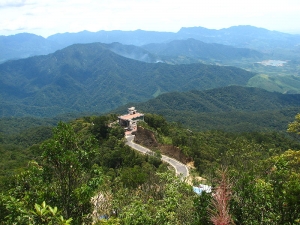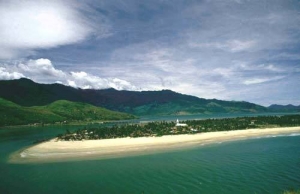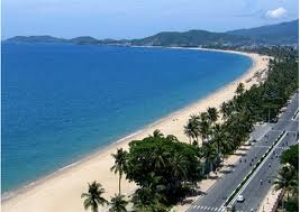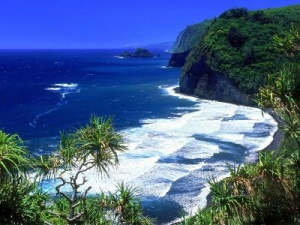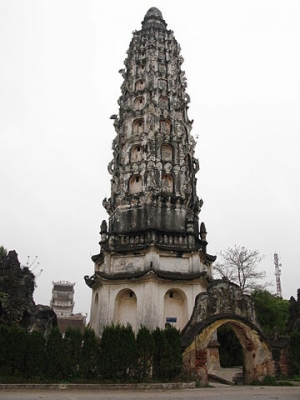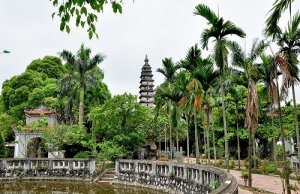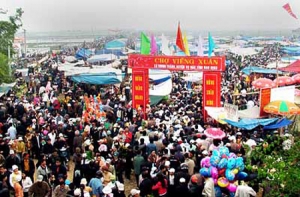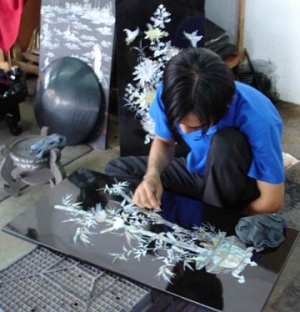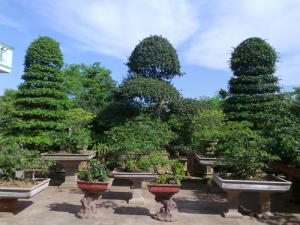
Asia Pacific Travel Team
Ba Na Hill Station
Rain often falls in the section between 700m and 1200m above sea level, but around the hill station itself, the sky is usually clear, the view is truly spectacular, and the air is fresh and cool. Mountain tracks lead to a variety of waterfalls and viewpoints.
Founded in 1919, of the 200-odd villas that originally stood, a few tattered, atmospheric ruins remain. Until WWII the French were carried up the last 20km of rough mountain road by sedan chair.
Near the top, the Linh Ung Pagoda (1999) is a supremely peaceful spot, with a 24m-high white seated Buddha visible for miles around. Near the pagoda a cable car (return ticket 35, 000d) whisks visitors up to the hill station. The vistas are huge.
The provincial government has high hopes of once again making Ba Na a magnet for tourists – branding it ‘the Dalat of Danang province’ and developing the site to suit domestic visitors. This has led to a variety of accommodation and restaurants, but also lots of karaoke, a loud PA and litter.
There are no ATMs up here, but there is a small post office (791 500) near Le Nim restaurant.
The charming Ngu Hanh Son Mountain
Ngu Hanh Son (Marble Mountain) is familiar to almost everyone who has been to Da Nang. It is so well known that many people consider it as the symbol of the area, one of the highlights on Central Vietnam’s tourist trail.
An interesting journey to Ngu Hanh Son will bring out most relaxing time for tourists in Vietnam travel . The mountain is a fairy land with a dreamlike scenery, pagodas, grottoes...

It is about 8km southeast of Da Nang City, ook like five fingers rising out of the ground. It was named after the five basic elements of the universe. This is a cluster of five marble mountains lying close to the sea. That is why, it is dubbed Hon Non Nuoc, which means Mountain and Water in Vietnamese.
For a start there are no mountains, these are merely hills. Nevertheless the ‘mountains’ are undoubtedly a bewitching and inspiring place.
Travelers in Vietnam travel will find mysterious grottos and secluded pagodas while enjoying the breeze off the great blue open sea. Nearby modern hotels and resorts take advantage of the stunning Non Nuoc beach that runs along Central Vietnam’s coastline. Every day, tourists in Vietnam travel come in numbers, each one seduced by the tranquil air and natural beauty.

Thuy Son is both the highest and the most beautiful. Marble mountains associates with many different legends. Thuy Son, covering an
area of 15ha, has three peaks namely Thuong Thai, Trung Thai and Ha Thai. As a result, the pagoda built on the mountain was named Tam Thai.
Thuy Son has been exploited as a popular tourist resort because of its alluring beauty. Stone steps carved into the mountain lead to Tam Thai Pagoda where Phat Di Lac is worshipped. In the past, the pagoda paid tribute to Hindu and Buddhist gods and is now dedicated to Cham deities. Also on the cliff of the mountain are such beautiful grottoes as Linh Nham Grotto, Van Thong Grotto, Tang Chon Grotto and Huyen Khong Grotto. Huyen Khong Cave was the base for Vietnamese revolutionaries during wartime.

A lot of the legends and folklore about the mountains have been spread through by word of mouth. Anyone visiting there is likely to come across someone - a child or a grey-haired old local selling incense or souvenirs - who will gladly tell some of the stories about the mountains of which they are so proud.
One local tale is that the mountains originate from egg shells. This legend of the Champa people says that a golden turtle came to the seashore and laid five eggs a long time ago. When the eggs hatched, their shells turned into the five mountains. Each mountain is made of different colored marble – there is pink marble in Water Mountain, white marble in Wood Mountain, red marble in Fire Mountain, water-colored marble in Metal Mountain and brown marble in Earth Mountain.The colors change under different lighting conditions and poets have compared the view to a beautiful girl contemplating the wind-swept East Sea. Tranquil and mysterious, the mountains have attracted the powerful kings to the most humble monks to admire their splendor.
When King Minh Mang came here in the 19th century he was famously besotted by the grottoes and pagodas. He is said to have considered it to be the pride of his southern kingdom. It was also Ming Mang who named the hills Ngu Hanh Son in Vietnamese after the five elements. The individual hills were christened Kim Son (metal mountain), Thuy Son (water mountain), Moc Son (wood mountain), Hoa Son (fire mountain) and Tho Son (earth mountain).
Princess Ngoc Lan, sister of King Minh Mang, lived there like a hermit and became a nun. Afterwards, a temple dedicated to her was constructed there. Many monks have been drawn by the tranquility. For instance, monk Hue Dao Minh was the first Buddhist to go there for meditation and religious practice in 1640.

The mountains inspired many great poets ensuring them a place on the map of Vietnamese literature. Poems from the Le and Tran dynasties have been preserved for young generations to enjoy in handwriting carved into the walls of caves high up in the cliffs. Pagodas built to honor the rulers of the Dinh, Ly, Tran and Le dynasties contain many valuable old objects and artifacts.
Cultural and historical vestiges are still on every pagoda and tower of the early 19th century and on Champa sculptures of the 14th and 15th century. There are poets of the Le and Tran dynasty engraved on stones. All monuments such as the grave of Capital Tran Quang Khai’s mother, a temple for worshiping Ngoc Lan princess (Minh Mang King’s younger sister), autograph of conferring Tam Thai pagoda to be the national one, Da Chong tunnel, Ba Tho cave, Kim Son mountain, Am Phu cave, etc. are forceful evidences to the legendary Marble Mountains.

Ngu Hanh Son are famous for their traditional stone engraving activities. In Dong Hai village close to Thuy Son, 600 families chisel stone producing statues, jewelry, and art work. Stone from the Marble Mountains has been exported to many countries. Though extracting rock directly from the area is now banned, sculptors are still here in numbers but materials are now transported to craftsmen from quarries elsewhere in Quang Nam province. All along the foot of the hills the sculptors ply their trade in small gardens, which double as workshops and outdoor showrooms. You will find traditional and modern motifs and imagery.
The sculptors cater for all kinds of visitors - Asian and European, the old and the young, flashpackers and backpackers. As you make your way towards the sculptures on display the hawkers will quickly surround you. Sculptures and other trinkets made here have been sold, boxed and dispatched all across the globe. Tourists in Vietnam travel can find a variety of statues, household items and assorted jewelry pieces.
Tourists in Vietnam Tourism can find enormous fantastical animals and fanciful statues from Vietnamese folk tales, pot-bellied Buddhas and some wonderful chessboards. There is literally something for everyone and the hawkers - as ever in Vietnam - would hate to see you go home empty-handed! Happier chiselling than trying to flog their wares, the community of artisans at the Non Nuoc Fine Arts Village keep their heads down throughout the day. Wandering in and around the mountains is a happy pursuit for any tourist in Vietnam travel .
Son Tra Peninsula, a special gift to Danang
It is 693m high above sea level; Son Tra Peninsula is 10km from the center of Da Nang City to the North-east. Son Tra Mountain can be seen from every place of the city. Son Tra looks like a mushroom of which cap is Son Tra Mountain and stalk is a beautiful sandy beach that affords an ideal area for bathing, swimming, playing sports and fishing.
Son Tra acts as a giant screen protecting Da Nang from storms and cyclones coming from the sea. Son Tra is put under the national protected forest regulation since it is a natural preservation area. The Peninsula is famous for its plentiful plants and fauna as well as the attractive scenery. It is said that fairies used to come here for singing, dancing and playing chess so Son Tra is also called Tien Sa (Fairies’ landing place). On this mountain, there still remain more than 30km² of natural forests, nearly 300 types of plants and several hundred kinds of fauna, including rare animal. From the top of the mountain, you can see the overall view of Da Nang City, Marble Mountains, Ba Na – Mount Chua.
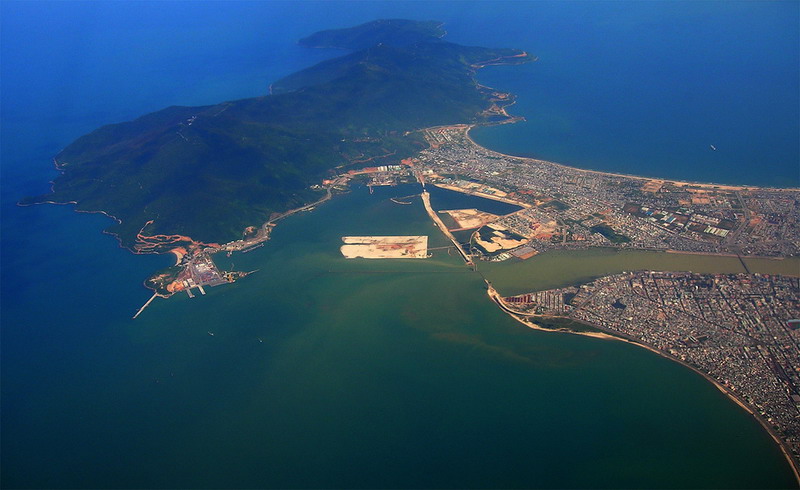
Suoi Da (Stone Stream) lies by the side of the foot of the mountain, fine sandy surfaces run round the peninsula, several breaks of waves are running steadily up and down and washing up on the stones heaped up around the seaside. All are attractive spots for tourists. It is so majestic and it is so romantic, it is so wide and it is really beautiful. In one-day stay at Son Tra, visitors in Vietnam travelcan enjoy living in the resplendent flow of dawn and the quietness of twilight on this fascinating landscape. And that is a time for them to realize the value of each and every moment and the true calling of the hearts. You can also swim in the cool sea and enjoy the fine view of the sandy banks run round the peninsula. The quiet Bai But offers you relaxing times sitting in small nice houses to hear the sound of waves and look swallows fly to the mount cliffs. The colorful coral reefs at the foot of the mountain are an ideal condition for the development of diving tourism.

It can be said that Danang means Son Tra Peninsula. It is a special gift of the god to Danang. If you have a chance to Danang and reach Son Tra, please come and get the real feeling of a different Vietnam.
My Khe Beach, an attractive resort of Danang city
With the length of a 30-kilometer coastline, Danang is famous for many beautiful beaches stretching from the north to the south and My Khe Beach is no exception. It is considered as one of the most beautiful beaches and also an attractive resort of Danang city. Annually, the beach attracts a number of tourists in Vietnam travel.
With the length of a 30-kilometer coastline, Danang is famous for many beautiful seashores stretching from the north to the south such as My Khe, Nam O, Xuan Thieu, Thanh Binh, Tien Sa, Son Tra, Bac My An, Non Nuoc. They are calm seas with green water during four seasons, not being polluted with 60% salination and high safety. With 900 meters in length, My Khe Beach is the most crowded of Da Nang beaches and popular to the locals.
The beach is located about 6km east of Da Nang and about 24km north of Hoi An. It is a nine-kilometer stretch of smooth sand with an average width between 50m and 70m. The gradient is gentle, and its sheltered position in the lee of the Son Tra peninsula softens the autumn winds that restrict swimming further down the coast.
My Khe is an ideal and huge beach with smooth sand and a slight slope. Behind the beach is a dark green poplar forest, and beside, the Kinh River carries crystal water to the sea. The beach has coral, abundant plants and creatures along bankside and under sea. Especially, the beach is next to the city centre, in roads easy to come and by various means of transport. Sea water in My Khe is cool with little wave so you can bath all year's round, especially in summer from May to August. The lack of large waves, less than average pollution, and an annual mean temperature around 25oC, makes it a safe place for both adults and children to go swimming.

Here, there are hotels, pleasure-houses and various abundant services, creating favorable conditions for tourists in Vietnam travel to relax on the seashores. There are 50 well-equipped and comfortable bedrooms and lots of services in My Khe hotel. Many luxurious seaside villas with over 100 rooms are available for families. You can come here to play and rest at weekend. Around the hotel area, there are lots of seafood restaurants and stalls, and large numbers of local vendors traverse the beach selling all kinds of foods and drinks. Visiting My Khe beach, the tourists will enjoy coastal specialties like shrimps, crabs, fish, cuttles, etc. in hundreds of small shops with reasonable price.
Before 1975, American soldiers occupied a part of the beach. They established some premises for their relaxation and recreations. With some enabling conditions such as being near the city’s center, large space, beautiful landscapes, and qualified services (hotels, restaurants, vehicles keeping site, fresh water bathing, sunshade and buoy lease), My Khe Beach is now convenient for developing kinds of services such as fishing, water-skiing, diving, yatch race and so on.
Moreover, the safeguard team of Da Nang seashore work from 5 a.m to 8 p.m every day to guarantee safety for visitors in Vietnam tourism to bath and relax on the beach. There has been a steady increase in the number of tourists visiting the beach.
Thanks to the completion of Han River suspension bridge which links the east to the west area, making transportation possible. As a result, My Khe Beach becomes an attractive resort to domestic and international tourists.
Non Nuoc Beach given a Name among World’s Beautiful Beaches
Danang has a coastline of 30 kilometres long, famous for many beautiful seashores stretching from the north to the south such as My Khe, Thanh Binh, Tien Sa, Son Tra and so on. Non Nuoc Beach also pertains to Da Nang Sea and has been voted as one of the most beautiful and attracting beaches of the planet, 2005, according to Forbes, the leading magazine of America. This beach has gentle slope, mild waves, and purely blue sea water during the four seasons. The unpolluted water source here has attracted a number of tourists coming to bathe, enjoy local special sea foods and take a rest for weekends. The beach Non Nước is also a place that exist precious and rare seaweeds such as gracilarias "yellow thread" and glacilaria "screw" that have high value of exporting.

With green water and white sand, Non Nuoc Beach stretches five kilometers along the shore of Hoa Hai Ward at the foot of Ngu Hanh Son (The Marble Mountains). The beach is famous for its seaweed, which reaches exportation standards. Many five-star hotels were built in Non Nuoc to accommodate the domestic and foreign tourists in Vietnam travel. Together with its feature of wave degree, climate, weather and salinity, Non Nuoc Beach is suitable for water sports, especially surfing. In 1993, there took place an international champion with the participation of nearly 40 athletes from many countries around the world.
Along the beach, on the white sand is a forest of age-old casuarinas which is shady, green and is waving in the whistling wind. This is an ideal place for resting and camping. When the darkness falls and the moon rises, you can set yourself free on smooth benches along the beach to listen to melodious sounds of the waves and enjoy the occult space.
The beach is managed by the Non Nuoc Tourism Company that has three hotels with more than 100 rooms on the beach. They provide entertainment services including photographs for souvenir, handicraft shops, massage, restaurant, tennis and some gymnastics. A chain of tourism resorts is planned to cater for international tourists including seaside hotels and restaurants, especially an international standard golf court.
Besides convalescence and bathing, tourists to Non Nuoc Beach can also combine their journeys with traveling the relic Marble Mountains, which boast some ancient pagodas and sacred monumental caves go around fine art stone handicraft villages right at the foot of the Mountains or go boating on Co Co River (Stork Neck River) to enjoy peacefulness of the Marble Mountains.
If you, foreign tourists, are making tours to Vietnam, I myself, a Vietnamese, advise you to come to Danang, a city of central Vietnam where there is Non Nuoc beach. It's an ideal destination in Vietnam travel that you should not ignore.
Co le pagoda - ancient pagoda with Ly Dynasty architecture
Location: Located in Co Le Townlet, Truc Ninh District, Nam Dinh Province.
Characteristics: It is said that Co Le Pagoda was built by Buddhist Monk Nguyen Minh Khong during the Ly dynasty.
From Nam Dinh, cross the hanging bridge over the Dao River, then take Highway 21 for 15km to Co Le. Finally, cross the small bridge and turn right. Co Le Pagoda is 200m away
Buddhist Monk Pham Quang Tuyen rebuilt the existing Co Le Pagoda in November 1920. In front of the pagoda is the 12-storey Cuu Pham Lien Hoa Tower built in 1926. The octagonal base of the tower sits on the back of a turtle facing the pagoda. In the tower, there is a huge staircase spiraling to the top of the tower. From the top, there is a panoramic view of the entire area.

A bridge leads to Phat Giao Hoi Quan
A bridge leads to Phat Giao Hoi Quan, a Buddhist meeting place, built in 1936. In addition to this bridge, the main pagoda can be reached by two other bridges in the mountains. In the center of the pagoda is a large 9,000-kg bell moulded in 1936. In the upper temple is the statue of Thich Ca Buddha; it is made of red lacquer trimmed with gold.
Several rare relics, such as a great red bell and bronze drums dating from the Ly dynasty, are kept in this pagoda.
If tourists in Vietnam Travel have chance to visit Nam Dinh province, Co Le pagoda is a must-see place that should not be missed!
Pho Minh pagoda - unique and ancient pagoda in Nam Dinh city
 A 7-tonne cauldron in Pho Minh pagoda
A 7-tonne cauldron in Pho Minh pagodaIf tourists in Vietnam Travel have chance to visit Nam Dinh province, Pho Minh pagoda is a must-see place that should not be missed!
Taking Part in Crowded Atmosphere of Vieng Market Festival
Vieng market festival is launched on the annual 8th day of the first lunar month. everyone go there to buy goods for praying for fortune and favourable nature, rich crops, happy family.
Legend has it that Vieng market is linked somehow to the person who brought copper casting to the area, Nguyen Minh Khong, so people who go the market feel that they will get lucky if they buy something made of copper at Vieng market on this day.
The market opens on the 8th of lunar January; nevertheless, the most spiritual moment falls on the night of the 7th and early 8th. That is the moment of heavenly-earthly, positive-negative exchange. According to the popular belief, at the time, men and Gods could reach together and all the prayers could be perceived more clearly. Trade could at the time take place smoothly. Consequently, there are 40,000-50,000 people coming to the market on the night of 7th let alone. The market on the night of 7th is called “Cho am phu” (Hades Market). There are about 10,000-12,000 people coming to the market on the following 8th. The market-goers not only just enjoy the market atmosphere but also bring along the feeling toward Mother, praying for fortune and favourable nature, rich crops, happy family. They buy and sell just for aspiration at luck in the rest of the year.
 Agricultural tools are sold in Vieng Market Festival
Agricultural tools are sold in Vieng Market Festival
Vieng market is actually typical to an agricultural countryside that is rich in natural products, a kind of radiant open-air “fair” produced by the local farmers, especially ornamental plants, speciality crops, subtle craft articles, utensils, bronze and iron-made tools, etc. This spring market displays handicraft products, antiquities and false antiquities, utensils, tools for agriculture production, and many kinds of ornamental plants. Specialities are barbecued beef and “bánh dày” (sticky rice cake).
 Buying flower and tree to have happiness and luck
Buying flower and tree to have happiness and luck
The cheapest things at Vieng would be flowers and trees, which bring both the buyer and seller happiness and luck. From around 2a.m, deals are done under the light of candles or flash-lights. Deals are agreed quickly, as people believe, to keep the luck. From 6a.m, local people bring farming tools such as hoes and sickles to sell, which relate closely to their lives. Buyers believe that the tools will bring them health and richness. Vieng market also is also a place to relax. Lovers would find themselves or their happy future here.
 burnt veal - indispensable gift from the Vieng market
burnt veal - indispensable gift from the Vieng market
Above all, everyone visiting the market just wish to buy the burnt veal at any cost, which is considered the indispensable gift from the market and bliss from fair of the Vieng market-goers. Accordingly, although the Vu Ban residents travelled anywhere, they just thought of the folk-song as a reminder:
"Enjoying the New Year’s day at home on the 1st
Engaging sports festival at communal house on the 2nd
Going to Qua Linh market on the 4th
Then Trinh market on 5th and Goi market on 6th
The following 7th is just for rest
Packing and travelling to Vieng market on 8th
Because it just takes place once a year."
If tourists in Vietnam Travel have chance to visit Nam Dinh province, you should take part in crowed atmosphere of Vieng Market Festival.
Nam Dinh - a beautiful landscape along with hiden charming and cultural value
Nam Dinh is a region with long history and culture involved in such relics as Pho Minh temple and Co Le temple. The festival as Phu Giay, Ha Ky and Bao Loc have always happened yearly in here. It at the Kiep Bac – gio Cha pilgrimage, we will be beheld a huge arge of river Luc Dau with brimful of vitality to the water, then at Phu Giay – gio Me, you should be able to contemplate a blue – immenes sea of vitality to the earth. In Viet people’s mind inner feeling at the Red river was still maintained a mass of temples, churches located around Phu Giay area as Gieng temple, Goi temple and Kham Sai temple and so on.
Talking about home village where has been got famous in lacquer of the North, we must mention about Cat Dang lacquer village in Nam Dinh, where has longest life of history. Someone said that lacquer was still be chosen to decorate for mausoleums and imperial palaces, which made by talented hands of Cat Dang’s artisan.
 Xuan Thuy national park in Nam Dinh province
Xuan Thuy national park in Nam Dinh province
Nam Dinh people are always proud of their land, where has biggest bird zoo in Vietnam. Located in Xuan Thuy’s flooded earth reserve, Ramsar is only place in Viet Nam, aside from a swamped area with 3.000 hectare of mangrove forest. This is very important in estuary’s ecosystem of the littortal. Xuan Thuy had recognized was a platform international birds for migration with more than 200 species, included nearly 100 spceies, for migration and over 50 species for migration and over 50 species of water birds by international ornithologist.
 soft green – lentil cake
soft green – lentil cake
Beside, Nam Dinh is also famous in their traditional specialist with soft green – lentil cake (che kho). It could keep longer 10 – 15 days but still get good smell if we cook in strict accordance with recipes. This reason makes Nam Dinh people are unforgettable the soft green – lentil cake in festovals and New Year to their family.
Bach Thuan Garden Village- Vu Thu- Thai Binh
Coming to Bach Thuan, tourists in Vietnam travel seem to go into a miniature park with all the bold and light colors. Along the two sides of the village road is covered with the blue color of senna and apples. The Nature endows Bach Thuan garden village in Thai Binh with favorable conditions for the development of traditional gardens.
Bach Thuan is a rich and populous garden village, the edge of which is an alluvial field, which serves for the cultivation of mulberry, banana and sugarcane. Inside the village are fruit tree and ornamental plant gardens. There are various flowers and fruits during all four seasons: apples, guavas, plums, lemons, longans, sapodillas, oranges, tangerines, bananas and jack fruits.
At times of high tide, Bach Thuan’s roads flood and become small rivers. From one house to another one, visitors in Vietnam travel and locals must take boats.


